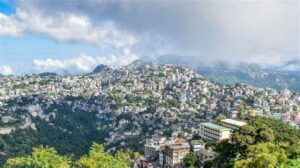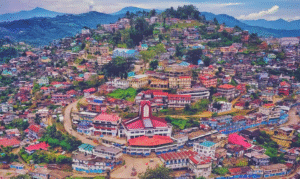Introduction
Dzukou Valley, located on the border of Nagaland and Manipur in Northeast India, is a region of extraordinary ecological significance and cultural relevance. Perched at an altitude of around 2,452 meters (8,045 feet) above sea level, this enchanting valley is often referred to as the “Valley of Flowers of the East.” It is best known for its seasonal blooms, including the rare and endemic Dzukou lily, as well as for its pristine environment, highland meadows, and natural caves. The valley’s untouched beauty and biodiversity make it an essential site for botanists, environmentalists, and cultural scholars alike.
This blog takes an educational and academic look at the geographical features, biodiversity, cultural associations, conservation challenges, and ecological importance of the Dzukou Valley. It highlights how this natural wonder is not only a visual marvel but also a living laboratory for ecological and ethnobotanical research.
1. Geographical Setting and Climatic Features
Dzukou Valley is nestled in the Senapati district of Manipur and partially extends into the Kohima district of Nagaland. The valley lies at the confluence of two distinct ecological regions—the Indo-Burma biodiversity hotspot and the Himalayan ecosystem. This strategic location gives it a unique microclimate and a blend of flora and fauna from both ecozones.
- Altitude and Terrain: The terrain is predominantly mountainous with gentle rolling meadows and steep cliffs. The valley is surrounded by the Japfü and Zakhama ranges, forming a natural amphitheater.
- Climate: The climate is temperate. Summers are cool and breezy, while winters can be harsh with sub-zero temperatures. The monsoon season is crucial for the blooming of seasonal flowers, including the famed Dzukou lily.
- Accessibility: Traditionally accessible by treks from Viswema and Zakhama villages near Kohima, the valley is remote and relatively less disturbed by commercial tourism, adding to its ecological integrity.
2. The Blooming Season and Floral Diversity
The Dzukou Valley comes to life during the monsoon months of June to September. The valley floor transforms into a vibrant carpet of wildflowers that stretch as far as the eye can see. The floral bloom is not just a spectacle of colors but also a reflection of the valley’s rich plant diversity.
- Dzukou Lily (Lilium chitrangadae): This rare and endemic species is unique to this region and was discovered only in the 1990s. It is often confused with the Shirui Lily of Ukhrul but is genetically distinct.
- Seasonal Flowers: The valley hosts hundreds of flowering species, including rhododendrons, aconitums, euphorbias, and anemones. Bamboo brush and dwarf bamboo add to the greenery, forming natural grasslands.
- Medicinal Plants: Indigenous communities are known to use various plants from the valley for herbal medicine. Ethnobotanical research has found over 50 medicinal species used for treating ailments like fever, wounds, and digestive disorders.
The floral diversity of Dzukou Valley is a valuable subject of study for botanists and conservation biologists aiming to understand the impacts of altitude, climate, and soil composition on plant adaptation and distribution.
3. Faunal Significance and Birdlife
Though primarily famous for its flowers, the Dzukou Valley is also home to diverse fauna, especially bird and insect species that thrive in this elevated environment.
- Bird Species: Dzukou Valley supports various highland bird species such as the Blyth’s tragopan (Nagaland’s state bird), Himalayan monals, and several species of thrushes and warblers.
- Mammals: Occasional sightings of Himalayan black bears, barking deer, and wild boars are reported, though systematic studies are limited due to the valley’s remoteness.
- Insects and Pollinators: Butterflies and bees play a crucial role in the pollination of the valley’s wildflowers. The interdependence of flora and fauna provides rich material for ecological symbiosis studies.
The faunal diversity adds another layer of ecological importance, making Dzukou a potential biodiversity hotspot that deserves more scientific attention.
4. Cultural and Spiritual Relevance
Dzukou Valley is not just a natural habitat; it also holds significant cultural and spiritual meaning for the indigenous tribes of the region.
- Folklore and Legends: The valley features in various oral traditions of the Angami and Mao Naga tribes. It is often described as a sacred place where divine beings once resided.
- Traditional Knowledge Systems: The indigenous people possess deep knowledge of the valley’s flora and their uses. For example, traditional foraging practices involve sustainable harvesting techniques that have been passed down through generations.
- Ritual Practices: Some tribal groups make pilgrimages to the valley for rituals connected to fertility, healing, and nature worship. These cultural practices underscore the intrinsic relationship between the people and the land.
By preserving Dzukou Valley, we also preserve the intangible cultural heritage tied to indigenous ecological wisdom and spiritual worldview.
5. Conservation Challenges and Environmental Threats
Despite its remoteness, Dzukou Valley is facing increasing threats due to changing environmental and human activity patterns.
- Forest Fires: In recent years, massive wildfires have engulfed parts of the valley, destroying vegetation and displacing wildlife. These fires are often human-induced, either accidentally by trekkers or intentionally for land clearing.
- Tourism Impact: While eco-tourism can generate revenue and awareness, unchecked footfall can damage fragile ecosystems. Littering, trail erosion, and unregulated camping are growing concerns.
- Climate Change: Erratic monsoon patterns, rising temperatures, and unpredictable frost have begun to affect the flowering cycle and ecosystem balance of the valley.
Environmental education and collaborative conservation initiatives involving local communities, researchers, and policymakers are essential to mitigate these risks.
6. Academic Research and Scientific Studies
Dzukou Valley presents vast opportunities for academic research across disciplines such as botany, ecology, anthropology, and climate science.
- Botanical Surveys: Ongoing efforts are being made to document the plant species of the valley and classify them according to their ecological function and medicinal value.
- Climate Impact Studies: Long-term monitoring of temperature, rainfall, and phenology (plant life cycles) in the valley can contribute to broader climate change research.
- Ethnobotany: Scholars are increasingly interested in recording and preserving traditional knowledge systems associated with the valley’s plant usage.
Universities and research institutes in Northeast India and beyond are encouraged to initiate interdisciplinary studies in the Dzukou region, ensuring that data collection is ethical and community-inclusive.
7. Sustainable Tourism and Community Engagement
For Dzukou Valley to thrive as a living ecosystem and a cultural landscape, sustainable tourism practices must be emphasized.
- Eco-tourism Models: Local village councils and community-based organizations are beginning to implement eco-tourism models that involve homestays, guided treks, and waste management practices.
- Capacity Building: Training local youth as eco-guides not only generates employment but also creates conservation ambassadors within the community.
- Policy and Governance: Government agencies from both Nagaland and Manipur need to coordinate conservation policies that transcend state boundaries and focus on integrated valley management.
Community-led stewardship models rooted in traditional values and modern conservation ethics can serve as templates for preserving other ecologically sensitive regions.
Conclusion
Dzukou Valley stands as a rare ecological marvel in the Northeast Indian landscape, where natural beauty converges with cultural heritage. With its unparalleled floral diversity, endemic species, and deep-rooted tribal traditions, it is more than just a picturesque destination—it is a repository of ecological wisdom, biodiversity, and sustainable living.
For students, scholars, and nature enthusiasts, the valley offers a multidimensional field of study, ranging from alpine ecology and floristic taxonomy to ethnobotanical knowledge and climate change impact. However, this natural wonder is fragile. Its continued preservation depends on responsible exploration, scientific research, and collaborative conservation efforts that respect both the ecosystem and the indigenous communities who have nurtured it for centuries.






